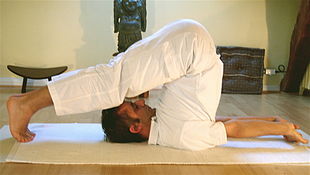
Halasana (Sanskrit: हलासन; IAST: halāsana) or Plough pose [1] is an inverted asana in hatha yoga and modern yoga as exercise. Its variations include Karnapidasana with the knees by the ears, and Supta Konasana with the feet wide apart.

Halasana (Sanskrit: हलासन; IAST: halāsana) or Plough pose [1] is an inverted asana in hatha yoga and modern yoga as exercise. Its variations include Karnapidasana with the knees by the ears, and Supta Konasana with the feet wide apart.

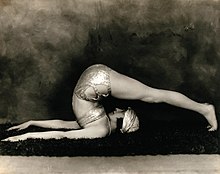
The name Halasana comes from Sanskrit हला hala, "plough" and आसन āsana, "posture" or "seat". [2] The pose is described and illustrated in the 19th century Sritattvanidhi as Lāṇgalāsana, which also means plough pose in Sanskrit. [3]
Karnapidasana is not found in the medieval hatha yoga texts. It is described independently in Swami Vishnudevananda's 1960 Complete Illustrated Book of Yoga in the Sivananda Yoga tradition, and by B. K. S. Iyengar in his 1966 Light on Yoga , implying that it may have older origins. [4] [5] The name comes from the Sanskrit words karṇa (कर्ण) meaning "ears", pīḍ (पीड्) meaning "to squeeze", and āsana (आसन) meaning "posture" or "seat". [6]
The pose is entered from Sarvangasana (shoulderstand), lowering the back slightly for balance, and moving the arms and legs over the head until the outstretched toes touch the ground and the fingertips, in a preparatory variant of the pose. The arms may then be moved to support the back into a more vertical position, giving a second variant pose. Finally, the arms may be stretched out on the ground away from the feet, giving the final pose in the shape of a traditional plough. [4] [7] [8] [9]
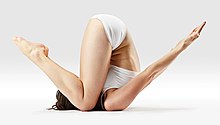
Karnapidasana (ear-pressing pose) or Raja Halasana (royal plough pose) has the knees bent close to the head and grasped by the arms. [10]
Parsva Halasana (sideways plough) has the body vertical, the trunk twisted to one side, and legs out straight with the feet touching the ground (to that side). [10]
Supta Konasana (supine angle pose) has the legs as wide apart as possible, the toes on the ground, like an inverted Upavistha Konasana; [11] the fingertips may grasp the big toes. [10]
All these variations may be performed as part of a cycle starting from Sarvangasana (Shoulderstand). [10]

Pashchimottanasana, Seated Forward Bend, or Intense Dorsal Stretch is a seated forward-bending asana in hatha yoga and modern yoga as exercise. Janusirsasana is a variant with one knee bent out to the side; Upavishthakonasana has the legs straight and wide apart.
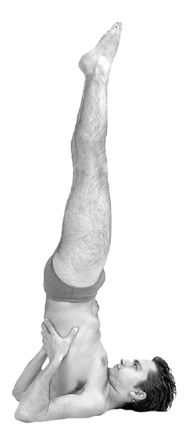
Sarvangasana, Shoulder stand, or more fully Salamba Sarvangasana, is an inverted asana in modern yoga as exercise; similar poses were used in medieval hatha yoga as a mudra.

Dhanurasana is a back bending asana in hatha yoga and modern yoga as exercise.
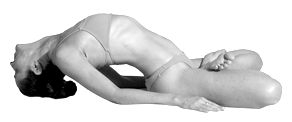
Matsyasana or Fish pose is a reclining back-bending asana in hatha yoga and modern yoga as exercise.

Bakasana, and the similar Kakasana are balancing asanas in hatha yoga and modern yoga as exercise. In all variations, these are arm balancing poses in which hands are planted on the floor, shins rest upon upper arms, and feet lift up. The poses are often confused, but traditionally Kakasana has arms bent, Bakasana has the arms straight.
Tadasana, Mountain pose or Samasthiti is a standing asana in modern yoga as exercise; it is not described in medieval hatha yoga texts. It is the basis for several other standing asanas.

Shavasana, Corpse Pose, or Mritasana, is an asana in hatha yoga and modern yoga as exercise, often used for relaxation at the end of a session. It is the usual pose for the practice of yoga nidra meditation, and is an important pose in Restorative Yoga.
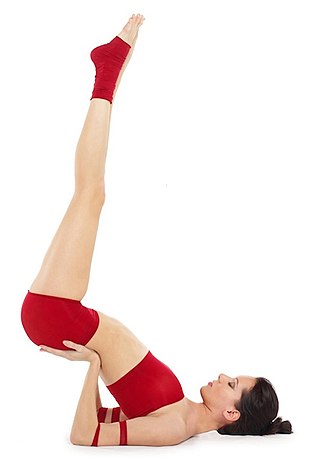
Viparita Karani or legs up the wall pose is both an asana and a mudra in hatha yoga. In modern yoga as exercise, it is commonly a fully supported pose using a wall and sometimes a pile of blankets, where it is considered a restful practice. As a mudra it was practised using any preferred inversion, such as a headstand or shoulderstand. The purpose of the mudra was to reverse the downward flow of vital fluid being lost from the head, using gravity.
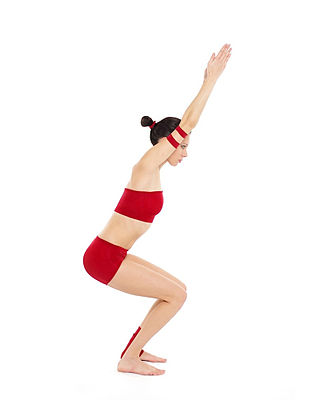
Utkatasana, Chair Pose, or fierce pose, is a standing asana in modern yoga as exercise. It was a low squatting asana in medieval hatha yoga.

Garbha Pindasana, Embryo in Womb Pose, sometimes shortened to Garbhasana, is a seated balancing asana in hatha yoga and modern yoga as exercise.

Kurmasana, Tortoise Pose, or Turtle Pose is a sitting forward bending asana in hatha yoga and modern yoga as exercise.
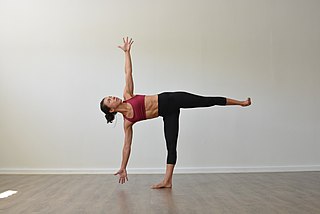
Ardha Chandrasana or Half Moon Pose is a standing asana in modern yoga as exercise.

Baddha Konasana, Bound Angle Pose, Butterfly Pose, or Cobbler's Pose, and historically called Bhadrasana, Throne Pose, is a seated asana in hatha yoga and modern yoga as exercise. If the knees rest on the floor, it is suitable as a meditation seat.
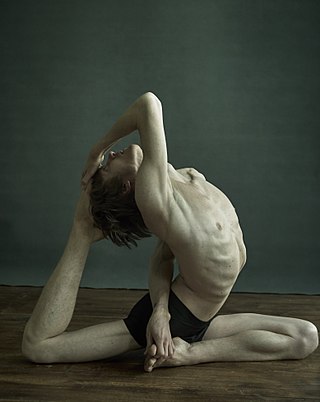
Eka Pada Rajakapotasana, Rajakapotasana, or [One-legged] King Pigeon Pose is a seated back-bending asana in modern yoga as exercise. The Yin Yoga form of the asana is named Swan Pose, while the Aerial yoga variant, supported in a hammock, is called Flying Pigeon Pose. The basic pose is described in the 20th century by two of Krishnamacharya's pupils, Pattabhi Jois and B. K. S. Iyengar; several other variants have been created. It is one of the yoga poses often used in advertising to convey desired qualities such as flexibility and grace.

Yoganidrasana, or Yogic Sleep Pose is a reclining forward-bending asana in modern yoga as exercise. It is sometimes called Supta Garbhasana. The name Dvi Pada Sirsasana is given to the balancing form of the pose.

Krauñcāsana or Heron pose, also written Krounchasana, is a sitting asana in modern yoga as exercise.
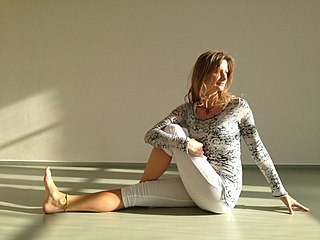
Marichyasana is a sitting twist asana in modern yoga as exercise, in some forms combined with a forward bend.
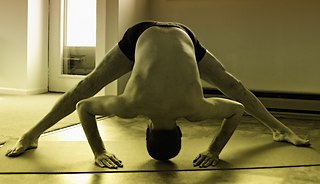
Prasarita Padottanasana or Wide Stance Forward Bend is a standing forward bend asana in modern yoga as exercise.

Setu Bandha Sarvāṅgāsana, Shoulder supported bridge or simply Bridge, also called Setu Bandhāsana, is an inverted back-bending asana in hatha yoga and modern yoga as exercise.

Jathara Parivartanasana, Revolved Abdomen pose, Belly twist, or Spinal twist is a reclining twist asana in modern yoga as exercise.
{{cite book}}: CS1 maint: multiple names: authors list (link)